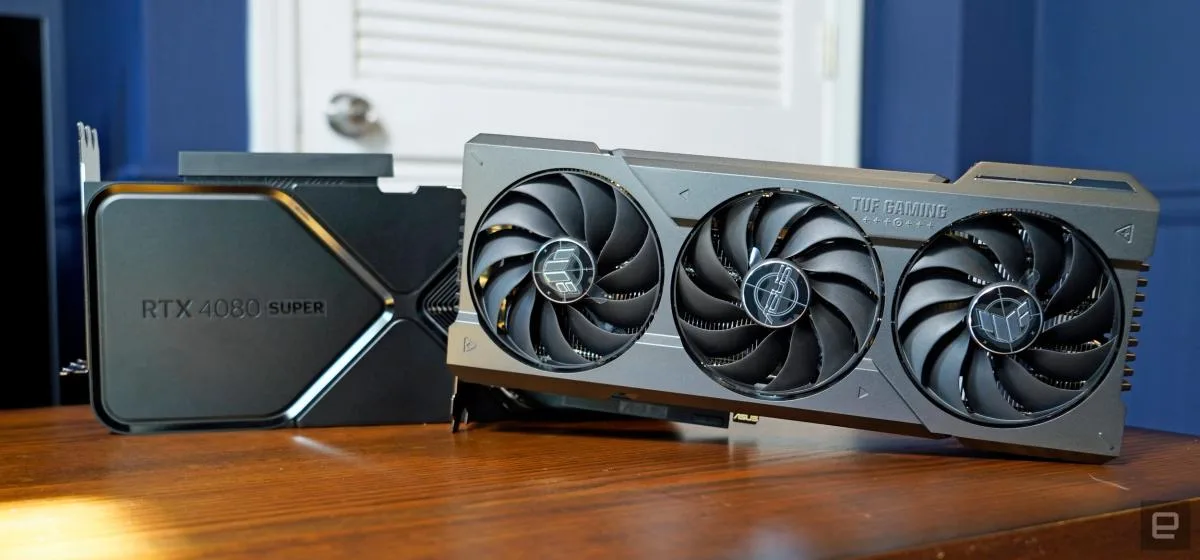But what about the new RTX 4070 Ti? He's stuck between his two siblings, with no clear audience. After all, if you're willing to spend $799 on a video card, stretching the 4080 Super a bit further might make more sense for the extra power. Otherwise, you might as well get the 4070 Super, overclock it a bit, and spend the extra $200 on another SSD or more RAM. This is a conundrum created entirely by NVIDIA, which could have been solved by giving the 4070 Ti Super a slight $50 discount. (And it's even more confusing when some cards, like the ASUS model we reviewed, are priced above MSRP.)
The RTX 4070 Ti Super is faster than the original 4070 Ti, but it now finds itself in a confusing position between the $599 4070 Super and the $999 4080 Super.
- Excellent 1440p and 4K performance
- Faster than the 4070 Ti
- Cool temperatures
- The price has not changed from $799
Just like the 4070 Super, the 4070 Ti Super and 4080 Super feature more CUDA cores than the original models, as well as slightly higher clock speeds. The 4070 Ti Super packs 8,448 CUDA cores compared to 7,680 on the 4070 Ti, while the 4080 Super has 10,240 CUDA cores instead of 9,728. The 4070 Ti Super also has an additional 4 GB of VRAM, bringing it to 16GB of GDD6X memory, while the 4080 Super sticks with 16GB. (NVIDIA probably doesn't want to get much closer to the beastly RTX 4090, which now sells for hundreds of dollars more than its original launch price of $1,599.)
The 4080 Super is a safe bet for high-end gaming, as it's both faster and $200 less than its predecessor.
- Excellent 4K and 1440p performance
- Cool performance with quiet fans, Cool performance with quiet fans
- Still much more expensive than previous high-end cards
Given the RAM increase, I expected the RTX 4070 Ti Super to be much faster than the 4070 Ti, but it ended up scoring just 742 points higher in the 3DMark TimeSpy Extreme benchmark. It fares better in gaming, scoring 15fps higher in both cases. Halo Infinite (104 frames per second) And Cyberpunk 2077 (93 frames per second) while gaming in 4K with maximized graphics and ray tracing settings. The 4080 Super's results were also muted: it achieved 289 points higher than the 4080 in TimeSpy Extreme, and it was 10 fps higher in Cyberpunk (103 fps) when gaming in 4K with ray tracing.
None | 3DMark TimeSpy Extreme | Port-Royal (Ray Tracing) | Cyberpunk | Blender |
NVIDIA RTX 4080 Super | 13,168 | 18,435/85 fps | 1440p RT Overdrive DLSS 180 fps4K RT Overdrive DLSS 105 fps | 8,867 |
NVIDIA RTX 4070 Ti Super | 11,366 | 15,586/72fps | 1440p RT Overdrive DLSS 165 fps4K RT Overdrive DLSS 93 fps | 7,342 |
NVIDIA RTX 4070 Super | 9,830 | 12,938/60fps | 1440p RT Overdrive DLSS: 157 | 6,177 |
NVIDIA RTX 4070Ti | 10,624 | 14 163/66 fps | 1440p RT DLSS: 135 fps | 7,247 |
Content creators will also appreciate the extra power. The 4070 Ti Super scored 87,707 points in the Luxmark HDR benchmark and 7,424 points in the Blender test, compared to 75,997 and 7,247 on the 4070 Ti super. The 4080 Super achieved 99,515 points in Luxmark HDR, up from 94,832 points.
These are the results you'd expect from simply adding more CUDA cores into these cards, so I'm not really disappointed. But after comparing the two GPUs and comparing their results to those of the 4070 Super, I'm even more disappointed with the 4070 Ti Super. I can understand NVIDIA not wanting to make it much faster, but it seriously needs to be cheaper than the original 4070 Ti. Otherwise, as I said, the 4070 Super is much more compelling, and I wouldn't be surprised if cheaper 4070 Ti cards appear.
We examined the ASUS TUF Gaming 4070 Ti Super (which currently sells for $850), as well as NVIDIA's Founders Edition 4080 Super. The ASUS GPU sports three fans and a typical heatsink design, while the NVIDIA card once again uses its unique (and very efficient) vapor chamber cooling setup. Both cards hovered around 75 degrees Celsius under load, but the ASUS GPU was noticeably noisier thanks to those three large fans. I could still hear the 4080 Super spinning under pressure, but it wasn't as loud.
If you can't tell by now, the main selling point of the 4080 Super is that it costs $200 less than the original. Not only is it a better deal in its own right, but its lower price should (hopefully) eventually help reduce the cost of older 4080 cards as well. And if you're not willing to shell out $999 for a video card , so the $599 4070 Super is no slouch either.

